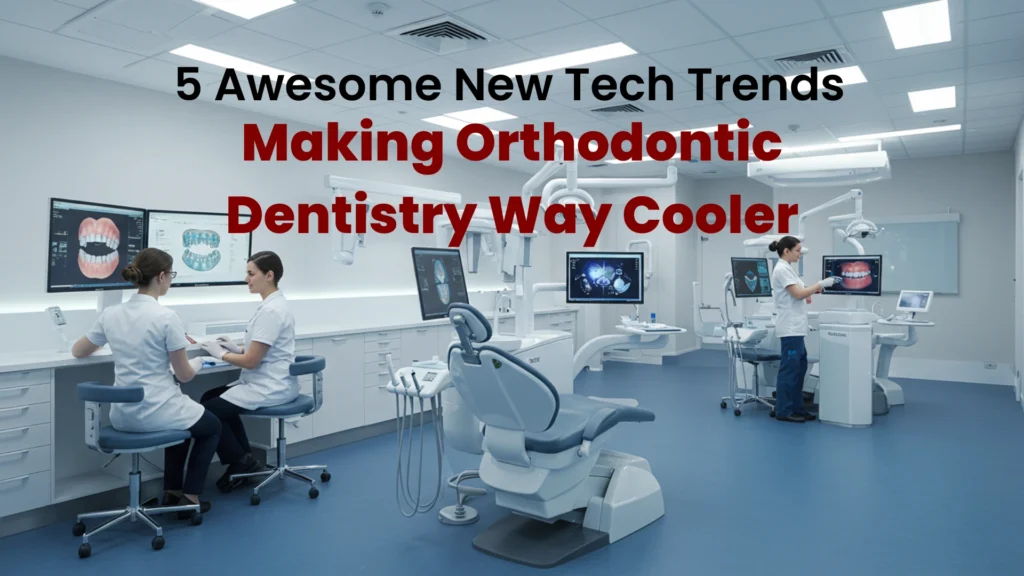
5 Awesome New Tech Trends Making Orthodontic Dentistry Way Cooler
Table of Contents
Orthodontic dentistry is getting a serious glow-up—and it’s honestly pretty exciting! From 3D-printed aligners to AI that’s practically a mind reader, the latest advancements are changing the game for dentists and patients alike. Whether you’re a dental professional, clinic owner, or just curious about the future of straighter smiles, keeping up with these innovations is a must.
Let’s take a fun, easy-to-digest look at the coolest breakthroughs in orthodontic dental technology, how they work in real life, and why top-quality dental instruments for orthodontics are the secret sauce behind it all.
1. 3D Printing: Custom Aligners in a Flash
Imagine needing new aligners, and instead of waiting weeks, your dentist prints them right in the office. That’s the power of 3D printing in orthodontics! This tech uses digital scans of your teeth to create custom aligners, retainers, or models—quickly and precisely.
Take Invisalign, for instance. Many clinics now use 3D printers to produce clear aligners that fit like a glove, because they’re made just for you. Dentists can also print treatment models to fine-tune the plan before starting, kind of like tailoring a bespoke suit for your teeth.
But none of this works without precise tools. High-quality scanners, calipers, and other instruments ensure accurate measurements. Using poor tools is like baking with a broken measuring cup—it just won’t turn out right.
2. Intraoral Scanners: No More Goopy Molds
Raise your hand if you’ve ever gagged on those gross dental molds. (Us too!) Intraoral scanners solve that. These magic wands capture a 3D image of your teeth in minutes—no mess, no stress.
For dentists, they deliver ultra-accurate data for designing braces and aligners. For patients, it’s a total win—faster, more comfortable, and more precise.
Real-life example? A quick scan can be sent to a lab or in-house printer, and voilà—custom aligners in just days. These scanners can even detect early crowding. Pair them with the right tools, and clinics get a seamless digital workflow.
3. AI: Your Dentist’s Super-Smart Assistant
Artificial intelligence isn’t just for cars—it’s revolutionizing orthodontics, too. AI can predict how your teeth will move and help dentists create personalized treatment plans.
Apps like Dental Monitoring let patients take selfies of their teeth at home. The AI checks progress and alerts the dentist if something’s off, saving clinic visits and making treatments more efficient. It can even simulate your post-treatment smile!
But AI needs high-quality data to work its magic, and that means using precise instruments like digital calipers and imaging devices for perfect measurements.
4. CBCT Imaging: X-Ray Vision for Your Teeth
Cone Beam CT (CBCT) offers a superhero-level 3D view of your teeth, jaw, and roots—far beyond traditional X-rays. It’s a must-have for complex cases, like locating impacted teeth or planning jaw surgery.
For example, if a canine tooth is stuck in the gums, CBCT pinpoints its exact location so dentists can plan a minimally invasive approach. This means faster treatments and fewer surprises.
Used alongside intraoral scanners, CBCT creates a powerful digital map—but only when paired with the right orthodontic tools to bring that plan to life.
5. Self-Ligating Brackets & Smart Braces: Braces, But Smarter
Self-ligating brackets are the rockstars of modern braces. Instead of rubber bands, they use a built-in sliding mechanism, resulting in smoother movement and fewer dentist visits.
Then come smart braces, with tiny sensors that monitor force on teeth and send real-time data to the dentist. Think of it as your braces texting your doc updates!
Precision is key here. Placing these high-tech brackets requires specialized pliers, torque wrenches, and more, crafted by top dental manufacturing companies to ensure accuracy and comfort.
Why Awesome Instruments Make All the Difference
All this amazing tech—3D printers, AI, CBCT—depends on one thing: precision. And that starts with the right tools.
Whether it’s bracket placement or scanning accuracy, high-quality orthodontic dental instruments are the unsung heroes. They help dentists work faster, smarter, and with better results, leading to happier patients and smoother procedures.
Conclusion
The world of orthodontics is evolving fast, with 3D printing, AI, intraoral scanners, CBCT, and smart braces changing how treatments are done. For clinics and dental pros, keeping up with these advancements means offering quicker, more comfortable, and more accurate care.
But don’t forget the foundation: precision instruments. Investing in the best orthodontic dental tools ensures that all this incredible tech works flawlessly. When innovation meets precision, the result is a straighter, brighter smile—delivered faster than ever.
